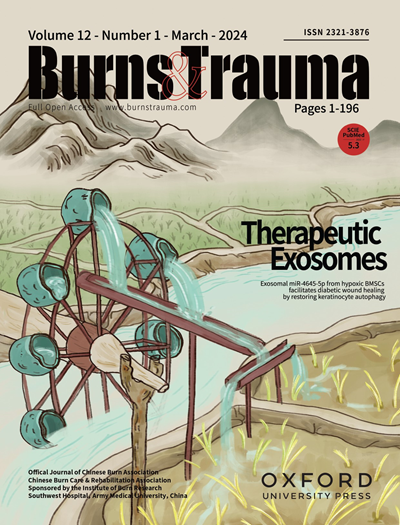富含at的相互作用域5A通过对接蛋白6在周围神经系统促进轴突再生
IF 9.6
1区 医学
Q1 DERMATOLOGY
引用次数: 0
摘要
外周神经的位置较浅,容易在意外外伤中受到损伤。与中枢神经的有限再生相比,损伤后周围神经具有一定的再生能力。然而,这种能力不足以实现功能恢复。为了提高神经损伤后的再生率,必须通过转录因子增加神经元中再生相关基因(regeneration associated genes, rag)的表达。方法建立SD大鼠坐骨神经压迫(SNC)动物模型。应用生物信息学分析和实时聚合酶链反应(qPCR)检测基因表达;应用免疫荧光染色和western blotting检测蛋白表达。体外培养DRG神经元,观察其轴突生长情况。鞘内注射腺相关病毒(AAV)在体内抑制或过表达靶标。转染后,采用坐骨神经挤压后新生轴突标记物(SCG10)的免疫荧光染色,评价富含at的相互作用结构域5A (Arid5a)或对接蛋白6 (Dok6)对轴突再生的作用。通过染色质免疫沉淀(ChIP)验证了TF与靶基因启动子的结合。结果在坐骨神经损伤后DRG神经元核内特异性聚集,在特定再生簇中具有较高的活性。siRNA抑制Arid5a后,体外神经突的生长和体内轴突的再生均受到抑制。相比之下,Arid5a在大鼠中过表达后,轴突再生明显加快。此外,Arid5a通过结合DRG神经元的启动子来促进Dok6的表达。抑制Dok6可抑制培养DRG神经元的神经突生长,而其过表达可促进体内轴突再生。此外,Dok6的过表达恢复了Arid5a抑制对轴突再生的受损作用。结论轴突损伤诱导神经元Arid5a核聚集。Arid5a通过Dok6在体外和体内加速DRG神经元的轴突再生。本研究丰富了我们对Arid5a在外周神经系统中的功能和参与神经再生的转录调控网络的认识。本文章由计算机程序翻译,如有差异,请以英文原文为准。
AT-rich interaction domain 5A facilitates axon regeneration through docking protein 6 in the peripheral nervous system
Background Peripheral nerves are easily damaged in accidental trauma due to their shallow location. Compared to the limited regeneration of the central nerve, the peripheral nerve has a certain regenerative ability after injury. However, this ability is not sufficient to achieve functional recovery. To increase the rate of regeneration after nerve injury, increasing regeneration-associated genes (RAGs) expression by transcription factors in neurons is necessary. Methods Sciatic nerve crush (SNC) animal models were generated in Sprague–Dawley (SD) rats. Bioinformatics analysis and real-time polymerase chain reaction (qPCR) were applied to detect genes expression; immunofluorescence staining and western blotting were applied to detect protein expression. The neurites outgrowth of cultured DRG neurons was performed to evaluate axon regeneration in vitro. Intrathecal injection of adeno-associated virus (AAV) was applied to suppress or overexpress the target in vivo. Following transfection, immunofluorescence staining of newborn axons’ marker (SCG10) in sciatic nerve after crush was used to evaluate the function of AT-rich interaction domain 5A (Arid5a) or docking protein 6 (Dok6) on axon regeneration. The binding between TF and the promoter of target genes was verified by chromatin immunoprecipitation (ChIP). Result has high activity in specific regenerating clusters and it accumulates specifically in the nucleus of DRG neurons after sciatic nerve injury. Upon Arid5a inhibition by siRNA, the outgrowth of neurites in vitro and the regeneration of axons in vivo were inhibited. In contrast, after Arid5a overexpression in rats, axon regeneration was significantly accelerated. In addition, Arid5a promotes the expression of Dok6 by binding to its promoter in DRG neurons. Suppression of Dok6 represses the neurites outgrowth of cultured DRG neurons, while its overexpression enhances axon regeneration in vivo. Furthermore, overexpression of Dok6 restored the impaired effect of Arid5a suppression on axon regeneration. Conclusions These findings indicate that axonal injury induced nucleus accumulation of Arid5a in neurons. Through Dok6, Arid5a accelerates axon regeneration of DRG neurons both in vitro and in vivo. This study enriched our understanding the function of Arid5a in the peripheral nervous system and the transcriptional regulatory network involved in neural regeneration.
求助全文
通过发布文献求助,成功后即可免费获取论文全文。
去求助
来源期刊

Burns & Trauma
医学-皮肤病学
CiteScore
8.40
自引率
9.40%
发文量
186
审稿时长
6 weeks
期刊介绍:
The first open access journal in the field of burns and trauma injury in the Asia-Pacific region, Burns & Trauma publishes the latest developments in basic, clinical and translational research in the field. With a special focus on prevention, clinical treatment and basic research, the journal welcomes submissions in various aspects of biomaterials, tissue engineering, stem cells, critical care, immunobiology, skin transplantation, and the prevention and regeneration of burns and trauma injuries. With an expert Editorial Board and a team of dedicated scientific editors, the journal enjoys a large readership and is supported by Southwest Hospital, which covers authors'' article processing charges.
 求助内容:
求助内容: 应助结果提醒方式:
应助结果提醒方式:


